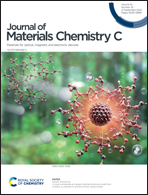Thermo-mechanical reversibility in a shape memory organic salt†
Abstract
The advent of exclusive mechanical deformations such as superelasticity, ferroelasticity, and the shape memory effect in organic compounds has opened up opportunities to explore intriguing mechanical properties in organic molecules pertaining to well-established structural materials like metal alloys and polymers. The configuration of mechanical properties with thermal energy in organic molecular crystals can be used for novel thermomechanical actuators and other advanced structural materials. In thermomechanical materials, dual external stimuli of temperature and stress can translate into the relationships between thermal energy and mechanical deformation, exhibiting a reversible shape change referred to as the shape memory effect. This paper reports a supramolecular organic salt displaying a shape memory effect with superelastic and ferroelastic interconversion on introducing external stimuli such as heat and stress. This temperature and stress-dependent shape-memory phenomenon in 1,2-bis(4-pyridyl)ethane dodecafluorosuberate, an organic salt, was investigated by force measurement, single-crystal X-ray diffraction (SCXRD), thermal analysis (differential scanning calorimetry (DSC), thermogravimetry (TG)), 13C solid-state nuclear magnetic resonance (NMR) spectroscopy and variable temperature powder X-ray diffraction (VT-PXRD) techniques to elucidate the structural changes at the macroscopic and molecular level.



 Please wait while we load your content...
Please wait while we load your content...